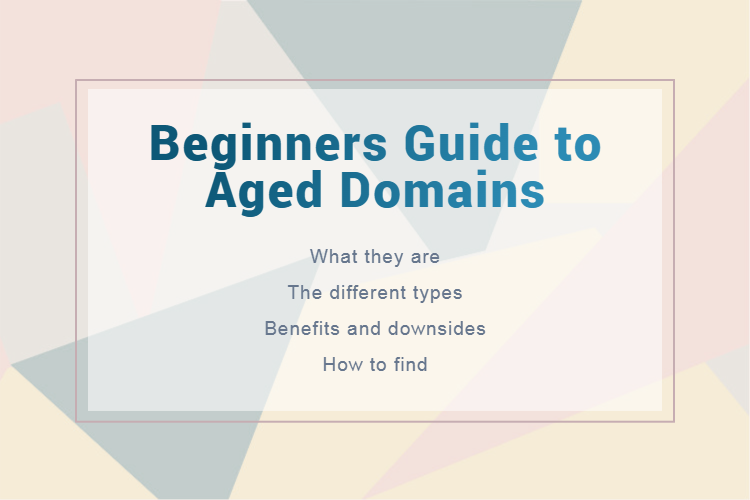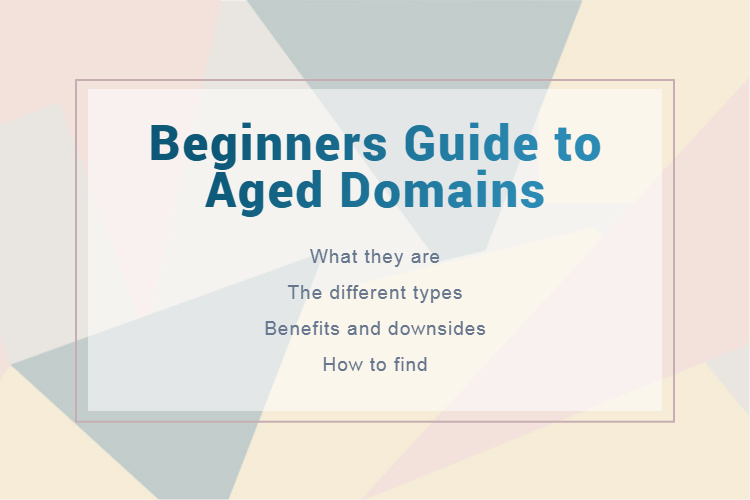Aged domains set the stage for a compelling narrative, offering a glimpse into a world where website authority and search engine visibility are paramount. These domains, seasoned with time and often boasting a history of online presence, hold a unique allure for website owners seeking to establish a strong digital footprint.
The concept of aged domains revolves around the idea that a domain’s age can positively influence its ranking in search engine results pages (SERPs). Search engines, like Google, often favor websites with a longer history, associating them with trustworthiness and credibility. This can translate into higher organic traffic, improved brand reputation, and ultimately, increased online success.
What are Aged Domains?
An aged domain refers to a domain name that has been registered and active for a significant period. The age of a domain is often considered a valuable asset in online marketing and .
Domain Age and Its Significance
The age of a domain is a key factor in search engine optimization (). Search engines, such as Google, consider domain age as a signal of trustworthiness and authority. Older domains tend to have more backlinks, higher domain authority, and a history of consistent website activity, which can contribute to better search engine rankings.
Examples of Aged Domains and Their Potential Benefits
- A domain registered in the early 2000s, for example, might have been used for a website that was once popular and generated a significant amount of traffic. Even if the website is no longer active, the domain itself retains its age and history, which can be valuable for a new website.
- An aged domain that has been consistently used for a particular industry or niche may have built up a strong reputation and brand recognition over time. This can be advantageous for a new website that wants to establish itself quickly in that market.
Sourcing Aged Domains

Acquiring an aged domain is a crucial step in building a successful website. Aged domains have a history of online presence, which can boost your website’s credibility and search engine rankings. Several methods and platforms exist for acquiring aged domains, each with its advantages and disadvantages.
Choosing Reputable Sellers
It is essential to choose reputable sellers when sourcing aged domains. This ensures you are getting a high-quality domain with a clean history and no associated penalties. Here are some tips for finding trustworthy sellers:
- Check their reputation: Look for reviews and testimonials from other buyers. You can find these on forums, domain marketplaces, and social media.
- Verify their contact information: Ensure they provide a legitimate website and contact details. Avoid dealing with sellers who use anonymous email addresses or phone numbers.
- Read their terms and conditions: Carefully review their policies on refunds, domain transfers, and other relevant issues.
- Trust your instincts: If something seems too good to be true, it probably is. Be cautious of sellers offering unrealistic discounts or guarantees.
Evaluating Domain Quality
Once you have identified potential sellers, you need to evaluate the quality of the domains they offer. This involves considering several factors, including:
- Domain age: Older domains generally have a higher value than newer ones. However, age alone is not a guarantee of quality.
- Domain history: Check for past website content, backlinks, and any penalties or blacklisting. You can use tools like Archive.org and Wayback Machine to see what the domain hosted previously.
- Domain metrics: Analyze metrics like Domain Authority (DA) and Page Authority (PA) to understand the domain’s overall strength and potential for .
- Domain s: Look for domains that are relevant to your niche and target s. This can give your website a head start in search engine rankings.
Purchasing and Transferring Aged Domains
The process of purchasing and transferring an aged domain can vary depending on the seller and platform. However, here are the general steps involved:
- Choose a domain: Select a domain that meets your requirements and budget.
- Make the purchase: Complete the purchase process and pay the agreed-upon price.
- Receive the domain transfer information: The seller will provide you with the necessary information for transferring the domain to your account.
- Initiate the transfer: Use your domain registrar to initiate the transfer process, providing the required details.
- Complete the transfer: Wait for the transfer to complete, which usually takes a few days.
Platforms for Sourcing Aged Domains
There are several platforms where you can find aged domains for sale. Some popular options include:
- Domain marketplaces: Sites like GoDaddy Auctions, Afternic, and Sedo offer a wide selection of aged domains. These marketplaces provide various tools and filters to help you find suitable domains.
- Domain brokers: Domain brokers are professionals who specialize in buying and selling domains. They can help you find high-quality domains and negotiate the best price.
- Domain forums: Forums like NamePros and WebmasterWorld are great places to connect with other domain owners and find domains for sale.
- Direct sellers: You can also contact domain owners directly and inquire about purchasing their domains.
Integrating Aged Domains

Integrating an aged domain into your existing website or a new project can be a powerful strategy for boosting your online presence and search engine rankings. Aged domains have a history of online activity, which can provide valuable signals to search engines, leading to improved trust and authority. However, a strategic approach is essential to maximize the benefits of aged domains while avoiding potential pitfalls.
Integrating Aged Domains into Existing Websites
The process of integrating an aged domain into an existing website involves a careful balance of preserving the domain’s history and leveraging its strengths while seamlessly blending it with your current website’s content and structure.
- Content Migration: Transferring relevant content from the aged domain to your existing website is crucial. Analyze the aged domain’s content and identify pages that align with your current website’s themes and target s. This process ensures that valuable content isn’t lost and helps maintain the domain’s authority.
- 301 Redirects: Implement 301 redirects from the aged domain’s pages to corresponding pages on your existing website. This ensures that search engines understand the permanent shift in location and redirect users to the appropriate content, preserving the domain’s link juice and preventing broken links.
- Link Building: Analyze the aged domain’s backlinks and identify high-quality links that can be leveraged for your existing website. Reach out to website owners and request that they update their links to point to your current website.
- Content Optimization: After migrating content, ensure it’s optimized for your target s and search engines. This involves updating meta descriptions, titles, and content to align with your existing website’s strategy.
Integrating Aged Domains into New Projects
When incorporating an aged domain into a new project, the approach is similar, but with a focus on establishing a new website’s foundation.
- Content Creation: Develop high-quality, relevant content that aligns with the aged domain’s history and your new project’s goals. This content should be optimized for search engines and provide value to users.
- Link Building: Build new backlinks to the aged domain, leveraging its existing authority to boost its rankings. This can involve guest posting, outreach campaigns, and creating high-quality content that attracts natural links.
- Website Design and Structure: Create a user-friendly website that complements the aged domain’s history and provides a seamless experience for visitors. Ensure the website’s structure and navigation are intuitive and optimize the website’s loading speed for a positive user experience.
- Monitoring and Analysis: Regularly monitor the aged domain’s performance using tools like Google Analytics and Google Search Console. Analyze traffic, rankings, and user engagement to identify areas for improvement and optimize your website’s strategy.
Potential Risks and Challenges: Aged Domains

While aged domains offer significant advantages, they also come with inherent risks and challenges. It’s crucial to conduct thorough due diligence and understand the domain’s history to mitigate potential problems.
Understanding Domain History
Understanding the history of an aged domain is critical to determine its suitability for your website. A domain’s past can reveal valuable insights into its reputation, past usage, and potential risks.
- Previous Website Content: Investigate the content previously hosted on the domain. This can reveal if the domain was associated with spam, malware, or other unethical practices. You may find valuable insights by using tools like the Wayback Machine (archive.org) to see past snapshots of the website.
- Domain’s Penalty History: Check if the domain has been penalized by search engines. Penalties can negatively impact your website’s ranking and traffic. Tools like Moz Open Site Explorer and SEMrush can help you identify past penalties.
- Domain’s Backlink Profile: Analyze the domain’s backlink profile to assess the quality and quantity of links pointing to it. A high number of low-quality backlinks can be detrimental to your website’s ranking. Tools like Ahrefs and Majestic can help you analyze the backlink profile.
Mitigating Risks
Once you understand the domain’s history, you can implement strategies to mitigate potential risks:
- Content Cleanup: If the domain has hosted inappropriate or low-quality content, it’s crucial to remove or update it. This helps improve the domain’s reputation and signal to search engines that the website is trustworthy.
- Backlink Disavow: If the domain has a high number of low-quality backlinks, you can use Google Search Console’s Disavow tool to tell Google not to consider those links. This helps improve the domain’s ranking and reduces the risk of penalties.
- Domain Redirection: You can redirect the aged domain to your new website. This helps preserve the domain’s authority and ranking while providing a seamless user experience.
Legal Considerations
Using aged domains for purposes presents a unique set of legal considerations. Understanding and navigating these legal aspects is crucial to avoid potential legal issues and ensure compliance with relevant laws.
Intellectual Property Rights
It’s essential to ensure that the aged domain you acquire doesn’t infringe on any existing intellectual property rights, such as trademarks or copyrights. This involves conducting thorough due diligence before acquiring the domain.
- Trademark Infringement: Ensure the domain name doesn’t resemble or is identical to a registered trademark. Using a domain that infringes on a trademark can lead to legal action and financial penalties.
- Copyright Infringement: If the domain previously hosted content that infringed on copyrights, you could be held liable for copyright infringement, even if you didn’t create the infringing content.
Due Diligence and Compliance
Before acquiring an aged domain, conduct thorough due diligence to ensure compliance with relevant laws and avoid potential legal issues.
- Domain History: Investigate the domain’s history, including its previous use and content. This helps identify any potential legal risks associated with the domain.
- Legal Status: Verify the domain’s legal status, including ownership and any outstanding legal claims or disputes.
- Content Review: Review the domain’s previous content for potential copyright or trademark infringements. Remove any infringing content to avoid legal liability.
Examples of Legal Issues
Here are examples of legal issues that may arise when using aged domains:
- Domain Name Disputes: Disputes over domain name ownership can occur, especially if the previous owner has a claim to the domain. This can lead to legal proceedings to resolve the ownership issue.
- Liability for Previous Content: You may be held liable for content that was previously hosted on the domain, even if you didn’t create the content. This could include copyright infringement, defamation, or other legal violations.
- Trademark Infringement: Using an aged domain that infringes on a registered trademark can result in legal action and financial penalties. This includes using a domain that is confusingly similar to a registered trademark.
Future Trends and Predictions
The landscape of digital marketing is constantly evolving, and aged domains are poised to play an increasingly significant role in shaping the future of online visibility and . As search engines become more sophisticated in their algorithms, the value of established domains with a history of trust and authority will continue to rise.
Emerging Trends and Technologies
The use of aged domains will be influenced by emerging trends and technologies that are redefining the digital marketing landscape.
- Artificial Intelligence (AI) and Machine Learning (ML): AI and ML are revolutionizing search engine algorithms, making them more intelligent and capable of understanding the nuances of content and user intent. This will lead to a greater emphasis on high-quality content and user experience, which aged domains can leverage to gain a competitive edge.
- Voice Search Optimization: Voice search is gaining popularity, and search engines are adapting to understand natural language queries. Aged domains with a strong backlink profile and relevant content can benefit from voice search optimization, as they are more likely to rank highly for long-tail s.
- Data Privacy and Security: As concerns about data privacy and security grow, search engines are placing greater emphasis on websites that adhere to best practices. Aged domains that have a history of compliance with data protection regulations and security standards will be seen as more trustworthy and reliable.
Last Recap
In the ever-evolving landscape of digital marketing, aged domains offer a valuable tool for enhancing website authority and driving organic traffic. By understanding the advantages, types, and potential risks associated with aged domains, website owners can make informed decisions about their acquisition and integration strategies. Whether it’s boosting a new website’s visibility or revitalizing an existing one, aged domains present a compelling opportunity to elevate online presence and achieve greater success in the digital realm.





